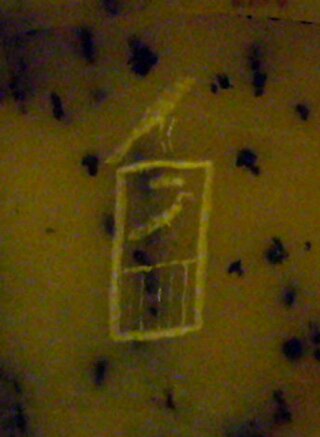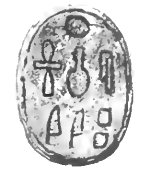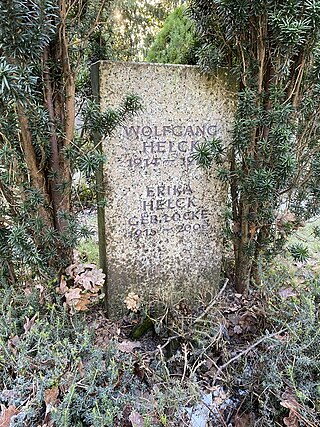
Nekhbet is an early predynastic local goddess in Egyptian mythology, who was the patron of the city of Nekheb. Ultimately, she became the patron of Upper Egypt and one of the two patron deities for all of Ancient Egypt when it was unified.

Khaba was a pharaoh of Ancient Egypt, active during the 3rd Dynasty of the Old Kingdom period. The exact time during which Khaba ruled is unknown but may have been around 2670 BC, and almost definitely towards the end of the dynasty.

Seneferankhre Pepi III may have been a pharaoh of the 16th Dynasty during the Second Intermediate Period. According to Wolfgang Helck he was the fifth pharaoh of the dynasty. Alternatively, according to Jürgen von Beckerath, he was the thirteenth pharaoh of the dynasty. Because his position in the 16th Dynasty is highly uncertain, it is not clear who were his predecessor and successor.

Hans Wolfgang Helck was a German Egyptologist, considered one of the most important Egyptologists of the 20th century. From 1956 until his retirement in 1979 he was a professor at the University of Hamburg. He remained active after his retirement and together with Wolfhart Westendorf published the German Lexikon der Ägyptologie, completed in 1992. He published many books and articles on the history of Egyptian and Near Eastern culture. He was a member of the German Archaeological Institute and a corresponding member of the Göttingen Academy of Sciences.

Ta-Seti was the first nome of Upper Egypt, one of 42 nomoi in Ancient Egypt. Ta-Seti marked the border area towards Nubia, and the name was also used to refer to Nubia itself.

Usersatet was an Ancient Egyptian official with the titles king's son of Kush and overseer of the southern countries. He was in office under king Amenhotep II and perhaps in the early years of the reign of Thutmosis IV. As king's son of Kush he was the main official in charge of the Nubian provinces.
Amenhotep was an ancient Egyptian official with the title king's son of Kush. In this function he was the main administrator of the Nubian provinces. Amenhotep was probably in office under Thutmosis IV.

Aksha is an ancient Egyptian temple, rebuilt in part at the National Museum of Sudan in Khartoum as part of the International Campaign to Save the Monuments of Nubia. The temple was built around 1250 BC by Ramses II. It is situated in the far north of present-day Sudan, a few kilometers south of Faras, on the west side of the Nile. On the temple walls, several sacrifices are depicted. The location of the temple was not well chosen, as it is only a few inches above the high tide of the Nile. This resulted in penetration of the lower wall layers, salt crystallization on the wall surfaces, and stones being worn down over the centuries. In addition, the temple was preyed upon by the local population. Other finds at the site include cemeteries, parts of Qubanstele, and the stele with the "blessings of Ptah".

Sekhemrekhutawy Khabaw was an Egyptian pharaoh of the early 13th Dynasty during the Second Intermediate Period.

Heqaib, also Hekaib or Hekayeb, was an ancient Egyptian nomarch of the 1st nomos of Upper Egypt under king Pepi II Neferkare, towards the end of the 6th Dynasty. He was also an officer in charge of military expeditions in Nubia.
Akhty was an ancient Egyptian deity. He was seldom mentioned.
Per-Wadjet was an Ancient Egyptian town in the 10th Upper Egyptian nome. The ancient town is identical with the modern village Kom Ishqau. Per-Wadjet is known from Egyptian sources since the New Kingdom. It was a cult place for Hathor, who was here identified with Wadjet. The Greeks identified Hathor with Aphrodite and called the town Aphroditopolis or Aphrodito. In Greek and Roman times the town was sometimes the nome capital. In Kom Ishqau were found the papyri of Dioscorus of Aphrodito, who lived there in the 6th century A.D. These papyri are an important source for life in Byzantine Egypt. A long-lost 2.200 year-old temple with words linked to Ptolemy IV Philopator was accidentally found during drilling work on a sewage project by the Egyptian archaeological mission in the village in early September 2019. Temple stones for installing the sewage pumps, limestone wall remnants and ground floor were also revealed during the excavation. Inscriptions described Hapi, the God of the Nile, presenting offerings of varied animal and birds in the walls of the temple.

Sarenput I was an ancient Egyptian official during the reign of pharaoh Senusret I of the 12th Dynasty.
Eberhard Otto was a German Egyptologist.

Heqanefer was an ancient Egyptian official in the New Kingdom under king Tutankhamun, who was a local governor with the title Chief of Miam. In the New Kingdom, Egyptian kings had conquered Lower Nubia. To secure control over the new region they appointed people of the local elite as governors. Miam was a town in Lower Nubia, a regional center and capital of the Nubian provinces. Here also resided the Chief of Miam. Heqanefer is known from his badly preserved rock cut tomb found at Toshka. Here he is depicted as Egyptian.
Djehutyhotep, also called Paitsy, was a Nubian official under Hatshepsut and Thutmosis III. He was chief of Teh-khet and was therefore a governor ruling a region in Lower Nubia of the Egyptian state. In the New Kingdom, Egyptian kings had conquered Lower Nubia. To secure control over the new region they appointed people of the local elite as governors. Teh-khet was a Nubian region that covered the area about Debeira and Serra. The local governors here formed a family, while the governor proper held the title chief of Teh-khet. Djehutyhotep's father Ruiu was also chief of Teh-khet. His mother was called Runia. His wife was called Tenetnub. His brother Amenemhat was also chief of Teh-khet and followed Djehutyhotep in office.
Ruiu was a Nubian official at the beginning of the 18th Dynasty. He was chief of Teh-khet and was, therefore, a governor ruling a region in Lower Nubia for the Egyptian state. In the New Kingdom, Egyptian kings had conquered Lower Nubia. To secure control over the new region they appointed people of the local elite as governors. Teh-khet was a Nubian region that covered about Debeira and Serra. The local governors here formed a family, whilst the governor proper held the title chief of Teh-khet.
In archaeology, Fadrus refers to a cemetery excavated in Lower Nubia close to a place once called Hillet Fadrus or Qadrus. It was lying in the district of Debeira-East. The cemetery was excavated in the early 1960s by a team of archaeologists from Denmark, Finland, Norway and Sweden, hence the expedition was called The Scandinavian Joint Expedition to Sudanese Nubia. The excavations were part of an international rescue program as the building of the Aswan dam flooded this area shortly after. The area is composed of 690 tombs ranging from interments without grave goods to decorated tombs-chapels.

The International Campaign to Save the Monuments of Nubia was the relocation of 22 monuments in Lower Nubia, in Southern Egypt and northern Sudan, between 1960 and 1980. The success of the project, in particular the creation of a coalition of 50 countries behind the project, led to the creation of the World Heritage Convention in 1972, and thus to the modern system of World Heritage Sites.











